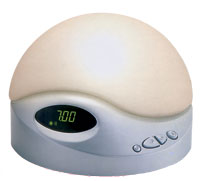Since the 1980s, light therapy often has been cited as an
effective way to treat seasonal affective disorder. The idea is that using
sunlamps to bring more bright light indoors boosts mood and keeps up
energy throughout the day.
Light therapy isn’t only for SAD sufferers. Researchers are
studying it as a treatment for other conditions, such as jet lag, sleep
disorders, and bulimia.
Even if you haven’t been diagnosed with SAD, light therapy is a
safe treatment for winter doldrums. Those who suffer from mild symptoms
might want to try it for two weeks, writes psychiatrist Norman Rosenthal
in Winter Blues: Everything You Need to Know to Beat Seasonal
Affective Disorder.
Light therapy involves 15 to 90 minutes of exposure to a
special fluorescent lamp each day during winter. Evidence suggests that
the bright light changes brain chemistry, according to the American
Psychiatric Association.
To ensure that you’re using a sunlamp properly, here are tips
from Neal Owens, a SAD sufferer in Frederick who helped the National
Institute of Mental Health develop effective sunlamps.
Start with 15 to 30 minutes of light therapy early in
the morning. Research shows that early-morning sessions are more
effective in treating winter blues. The response rate to sunlamps is 80
percent at 6 am versus 40 percent at 8 am.
Don’t stare at the sunlamp. While some light
should fall on you during each session, “don’t feel tied to the lamp,”
says Owens, who founded the SunBox Company after experiencing the benefits
of light therapy. Read a book, check your e-mail, or make breakfast. To
avoid eye damage, never look directly into the light.
Use light therapy daily. Irritability and low
energy may return if you skip light therapy for even two days, says Owens.
Stick to it daily, and don’t stop cold turkey the first day of spring.
Continue using the lamp through the spring or slowly wean yourself
off.
Choose lamps that emit 10,000 lux. Studies
have found that 10,000 lux is the magic number for treating seasonal
affective disorder because it’s the amount of light emitted at sunrise. A
study published in the American Journal of Psychiatry found that
patients reported mild headaches or eye problems at first, but the
symptoms didn’t interfere with treatment for seasonal affective
disorder.
Wait at least two to three weeks for results.
Don’t fret if you still feel moody or down after a few days of
light therapy. The benefits likely won’t kick in until weeks
later.
Let There Be Light: Three Good Choices
These sunlamps, each developed by companies that specialize in
light-therapy products, come highly recommended by Dr. Rosenthal—who has
six such lamps in his DC home.
1. HappyLight Liberty by Verilux, $99.95.
Although one-quarter the size of typical light boxes, this still
emits the recommended 10,000 lux. Weighing two pounds, it’s
travel-friendly and can stand on its own or be mounted on a
wall.
2. SunBox Desk Light by SunBox Company, $225.
This energy-efficient desk lamp allows you to get in 15 to 30
minutes of light therapy at the office. At almost two feet tall, it’s a
bit large, but the neck’s height can be bent and adjusted.
3. SunRay II by SunBox Company, $399.The
SunRay II features the classic design of light boxes, measuring 15½ inches
tall and 23 inches wide. The light is delivered at a downward angle for
maximum effectiveness, and the lux can be adjusted.
I Tried It: A Dawn-Simulator Lamp

sunbox.com.
Until last month, I lived for two years in an apartment where I
had a tiny, windowless bedroom. Every day I woke up in darkness. It made
for good sleep on weekends, but I found it tough getting out of bed the
rest of the time.
So, eager to wake up in a light-filled room and not a
pitch-black dungeon, I jumped at the chance to try out a dawn-simulator
lamp for a few weeks last winter.
The SunRise Digital Alarm Clock by the SunBox Company works
like a normal alarm clock, but a white orb is attached to it. Fifteen to
90 minutes before the alarm goes off, the orb begins emitting steadily
increasing light, reaching full brightness while the alarm beeps.
My
excitement about trying it might have played a role, but the first morning
I woke up a few minutes before my alarm time of 6:30 am and popped out of
bed. As the weeks progressed, I continued to welcome the soft light in the
morning. Even on days when I’d forgotten to set the alarm, I managed to
wake up within 15 minutes of my normal alarm time.
While the amount of
light emitted may be enough for someone sleeping in a room with windows,
after a month of getting used to the faux sunlight, I could have used an
even brighter bulb for my daily wake-up.
For nights when I had trouble
falling asleep, the sunset feature worked wonders. Thirty minutes before
bedtime, I turned the lamp to its brightest setting. Over the course of a
half hour, the light dimmed until I was enveloped in darkness—although I
often fell asleep before noticing.


















